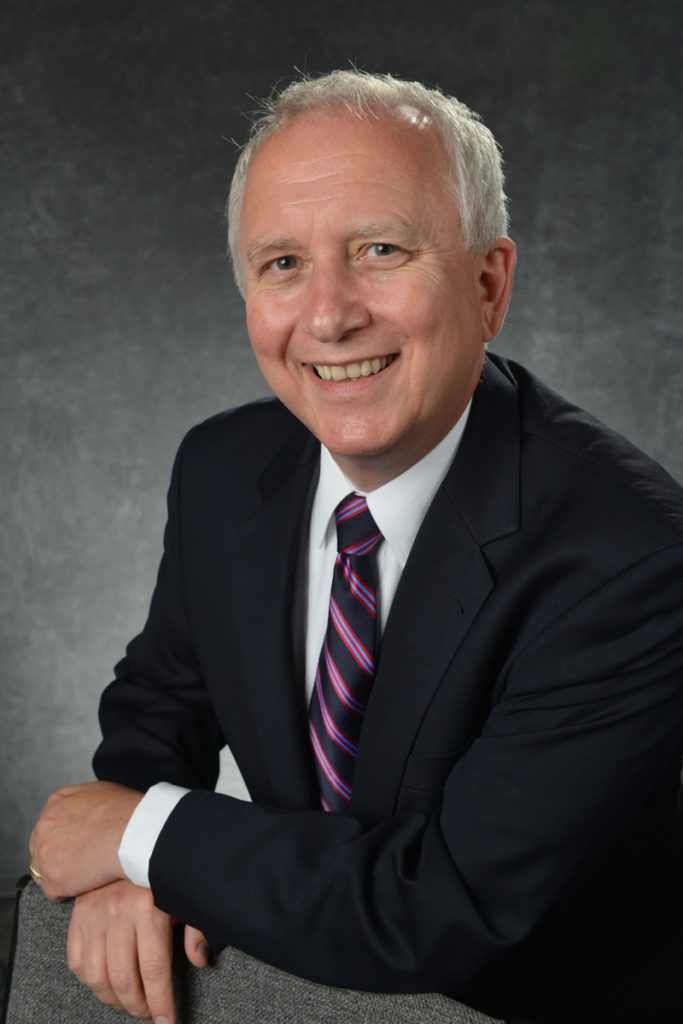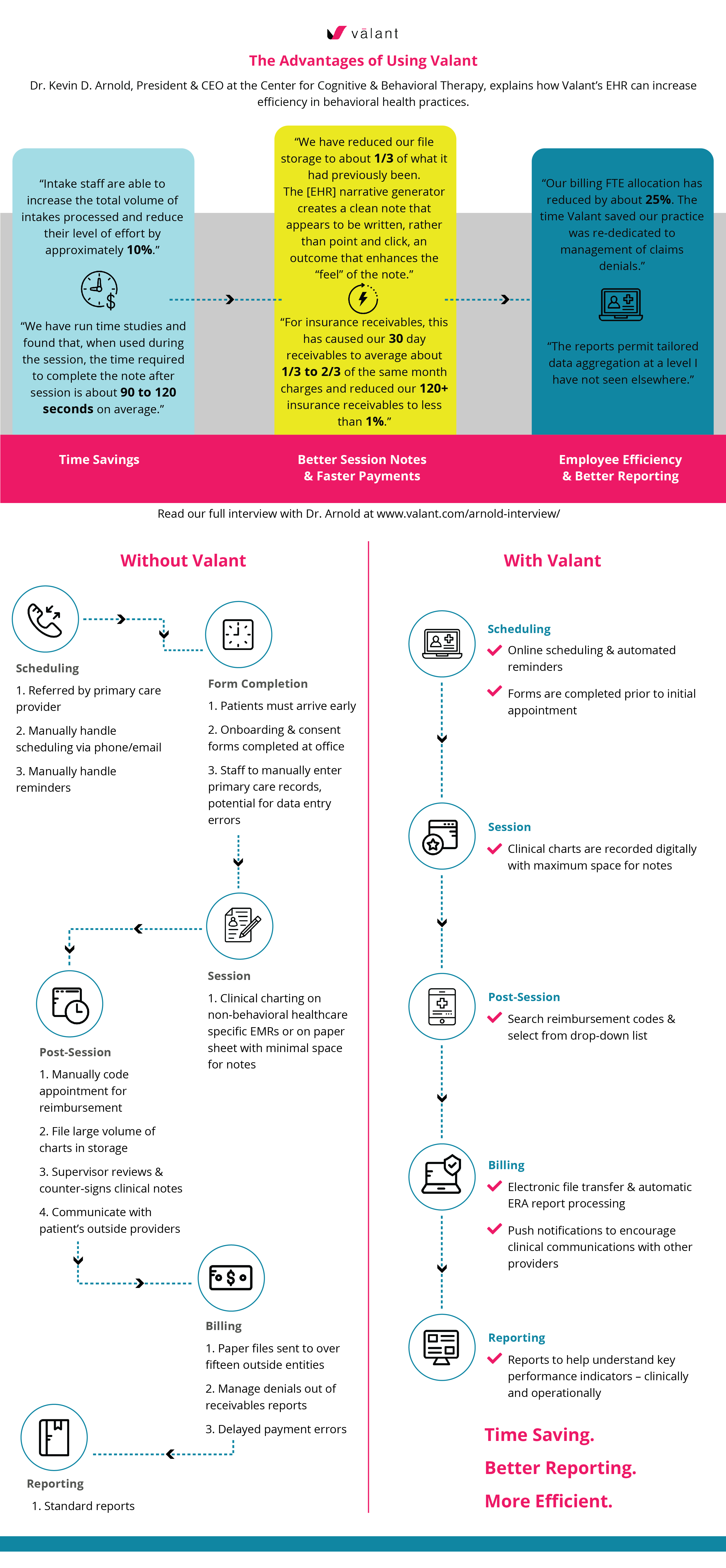
There’s no doubt that electronic health records (EHR) software like Valant can make healthcare provider offices more efficient. From centralized patient information to online appointment scheduling, an EHR is an opportunity for health professionals to streamline administrative operations, thus focusing their energy and attention on the quality of patient care they provide. Office staff endures fewer mundane tasks, health providers can extend their expertise across a wider network of patients, and even patients benefit from a more organized provider experience. Medical doctors and psychologists alike can attest to the benefits of implementing an EHR into their practice workflow.
Dr. Kevin D. Arnold, PhD, is one such psychologist who can attest to the benefits of using EHR — Valant, specifically. Now President and CEO at the Center for Cognitive & Behavioral Therapy in Columbus, OH, Dr. Arnold boasts years of industry experience and an acute understanding of the everyday operations of behavioral health practices. He’s more than qualified to speak on the topic of EHRs … so we decided to ask him a few questions about it.
In this interview, Dr. Arnold elaborates on how Valant has improved business at his practice.
What were the major pain points you and/or your practice experienced before using Valant?
Dr. Arnold: Before using Valant, we used an electronic office management software that also produced billing code files as well as managed charges and payments. But, for clinical charting, we used a paper form that was CBT structured, and provided minimal space for notes (e.g., agenda, homework). A significant problem with the office management software was the inability for clinicians to code appointments in the EHR, and for the paper forms the inability to share those forms easily with physicians (and the volume of storage required).
How did Valant work as a solution to these pain points?
Dr. Arnold: Valant allows providers to code encounters at the end of the session, speeding up billing, and eliminating keystroking for our full-time administrative billing office. Those solutions improved efficiencies in the office remarkably. The elimination of paper and having a centralized storage of e-records gives CCBT the flexibility to use space more efficiently and to access records for purposes such as a requested records release. In the past, we would be required to sort through archived records to fulfill a request or communicate with a primary care physician.
How many outside entities does your practice need to report to?
Dr. Arnold: Billing files must be transmitted to over 15 entities, not including EAPs. Billing entities require daily submission of billing code files, and we submit billing using that timeline to our claims processor dialing. Valant also allows us to process Electronic Remittance Advice (ERA) reports from our claim-processor. The latter is hugely efficient and reduces human resource hours dedicated in the past to keying in payment data.
Regarding payers, we also have used Valant’s reports to verify payer metrics reports for contract adherence to value-based payment enhancements. We also have found some reports in Valant to allow us to calculate payment per code data, which we’ve used for contract compliance for negotiated rates per code. When necessary we report these data to payers in order to recover shortages in negotiated rate payments. Provider entities require reports of referrals. We use Valant to create the referral demographic data capture, although the referral processing/workflow accomplishment is captured in an Excel spreadsheet. There are about 80 primary care provider entities to whom we will eventually report data, including intake reports (the report generated by the intake in Valant), clinical outcome reports (e.g., PHQ-9 change over time), and utilization reports (e.g., average number of sessions per provider entity office). The ability of the portal to push notices to complete clinical measures is important in this part of the work.
How has Valant helped increase productivity and revenue growth for your practice?
Dr. Arnold:
- Patient Portal/Intake
The intake shell has increased efficiencies in the demographic data capture compared to our previous EHR. Formerly, we had to use paper forms to capture the demographics, then key those into the former EHR. The costs of the old process were not just human resource time, but also keypunching errors when transcribing. While those errors continue minimally, there has been both a reduction in time and errors with Valant. The Portal has only been onboarded in the last two months. We have not employed it fully, since creating consent forms for it has taken some time. However, we intend to use it for both communication and to capture clinical outcome data. - Scheduling
Scheduling has increased in efficiency because the scheduler serves as a central hub for appointment management within Mobile Notes. This allows our clinicians to use the scheduler for both appointments and documentation/billing. Our administrative staff are also able to not just schedule more efficiently, but we can manage patient data in the notes section, such as outstanding balances due. The notes have led to a dramatic reduction in patient-responsibility receivables (less than 2% at 120+ days) compared to before. - Clinical Documentation
The structured note form is remarkably efficient. We train our clinicians on its use when they are contracted or hired. We have run time studies and found that, when used during the session, the time required to complete the note after session is about 90 to 120 seconds on average. The narrative generator creates a clean note that appears to be written, rather than point and click, an outcome that enhances the “feel” of the note.The capacity of the notes to be counter-signed by supervisors has proven important to our office. We have contractual permission from several payers to bill supervisees who meet various educational and experience criteria. During one site visit, the unsigned chart note report combined with the supervisor counter-signature capacity led to that payer to approve our office for a supervision protocol. - Billing
Billing is remarkably quicker with the drop-down coding feature. In the past, our providers would use paper superbills to bill, turning them into billing in an often-less-than-timely fashion. With Valant, we can track unbilled appointments through report, and follow up with one to two days with providers who have not yet billed sessions. For insurance receivables, this has caused our 30-day receivables to average about 1/3 to 2/3 of the same month charges, and reduced our 120+ insurance receivables to less than 1%. - Reporting
Reporting functions are much easier now that we have both the standard reports (like those from our earlier EHR) and the “Beta” reports that allow for much more fine grain analyses. The Beta reports permit tailored data aggregation at a level I have not seen elsewhere. We use those reports to manage our business much more effectively.
What are major complaints that you hear from colleagues about their EHRs or paper processes and what is your response to them?
Dr. Arnold: I’m not sure I hear much in the way of complaints. But, when I’m hired to evaluate a practice, I point out significant short-falls and can illustrate, using Valant, how much more efficient and effective an EHR/EOMS can be. While I don’t flat-out recommend Valant to those practices, I use only it to illustrate efficiencies and effectiveness. Cleary, though, the superiority of Valant to paper records is obvious, and with the upload option, nothing (including test protocols) should be kept in paper files. We have reduced our file storage to about 1/3 of what it had previously been. When we consider a practice for acquisition, a key feature of our offer is access to Valant. We illustrate the time efficiencies in documentation and billing, along with the improved payment timing, as key features of our practice’s advantage over their existing workflows. When we’ve acquired practices, these promises of improved efficiency and receivables conversion have proven true.
How, if any, has Valant lead to allowing your scheduling/intake team to concentrate on other areas of the new client life cycle – as a result of Valant’s portal/scheduling/intake functionality?
What percent of your overall FTE time has been shifted to other value add areas of the business?
Dr. Arnold: The efficiencies from Valant have produced time savings, such that our intake staff are able to a) increase the total volume of intakes processed and b) reduce their level of effort by approximately 10%. The additional time is used to manage transmittal of care coordination documentation to primary care offices. The result of the improved care coordination has been an increased volume of intakes, so that the efficiencies have both produced more effective office operations and increased total caseloads.
How, if any, has Valant lead to allowing your billing/reporting team to concentrate on other areas of revenue cycle management – as a result of Valant’s billing functionality?
What percent of your overall FTE time has been shifted to other value add areas of the business?
Dr. Arnold: Our billing FTE allocation has reduced by about 25%. The time Valant’s billing software saved our practice was re-dedicated to management of claims denials. By re-distributing the human resources, CCBT has an improved claims processing through dedicated resources which resolve claims denials in real-time. The time-savings from Valant, and as a result of this human resource re-allocation, led to an additional reduction in delayed payments of claims. We used to management denials out of receivables reports, a process that can delay payment as much as 60 to 90 days. Valant has allowed our office to greatly improve both our total payments and the timeliness of those payments.
How, if any, has Valant lead to an increase in number of clients being seen by your clinicians?
What percent increase in productivity have you seen as a result of streamlining clinical operations via Valant?
Dr. Arnold: Since Valant, our clinicians have been able to improve their patients’ experiences through improved percentages of starting sessions on-time due to the speed of clinical note completion. Our office uses the structured session note, and those clinicians who use it properly are able to complete notes within 90 to 120 seconds after their clients leave. We have done time studies and the range is consistent, creating improved client satisfaction and patient retention.
In addition, the thoroughness of the intake notes, particularly the measures, has received consistent positive feedback with primary care offices when those notes are sent to them to facilitate care coordination. The capacity to generate narrative content from “point-and-click” forms has created increase referral volume from physicians.
Learn more about Valant’s billing software for mental health clinics.





